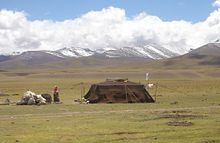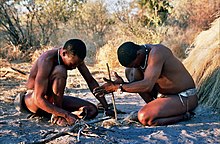Nomad
Nomadic people (or nomads) are people who move from one place to another, instead of living in one place. The best known examples in Europe are the Roma, Sinti, and Irish Travellers. Many other ethnic groups and communities are traditionally nomadic, like the Berbers, Kazakhs, and Bedouin.



Why are people nomadic?
changeMost nomads are family men herding their livestock (like cattle or horses) from pasture to pasture. To find food for their stock and avoid bad weather, they have to move their herds from place to place. Nomads who follow their herds (like the Mongols) usually live in tents with few things inside.
Other nomads are traders and craftsmen (people who make things). They travel to exchange goods or to practice their craft where it is needed. These nomads usually travel in wagons because they are better for carrying goods.
Other nomads follow animals. For example, the Sámi of Lapland are a semi-nomadic tribe that follow a herd of reindeer. The Sámi are a migratory people who lead their own herd of reindeer to winter feeding grounds and then return them in the spring to their feeding ground close to a permanent home base, where their family lives. This cycle happens every year.
Mobile warfare
changeThe skills of nomadic life can be useful in mobile warfare, and have been used in attacking sedentary agricultural and urban people. Genghis Khan and the Mongol hordes, for example, conquered vast areas in Asia by organizing themselves as cavalry.[1][2]
References
change- ↑ Kradin, Nikolay N. 2003. Nomadic Empires: origins, rise, decline. In N.N. Kradin, Dmitri Bondarenko, and T. Barfield (eds) Nomadic pathways in social evolution. (p. 73-87). Moscow: Center for Civilizational Studies, Russian Academy of Sciences.
- ↑ Weatherford, Jack 2004. Genghis Khan and the making of the modern world. Crown and Three Rivers Press. ISBN 0-609-80964-4